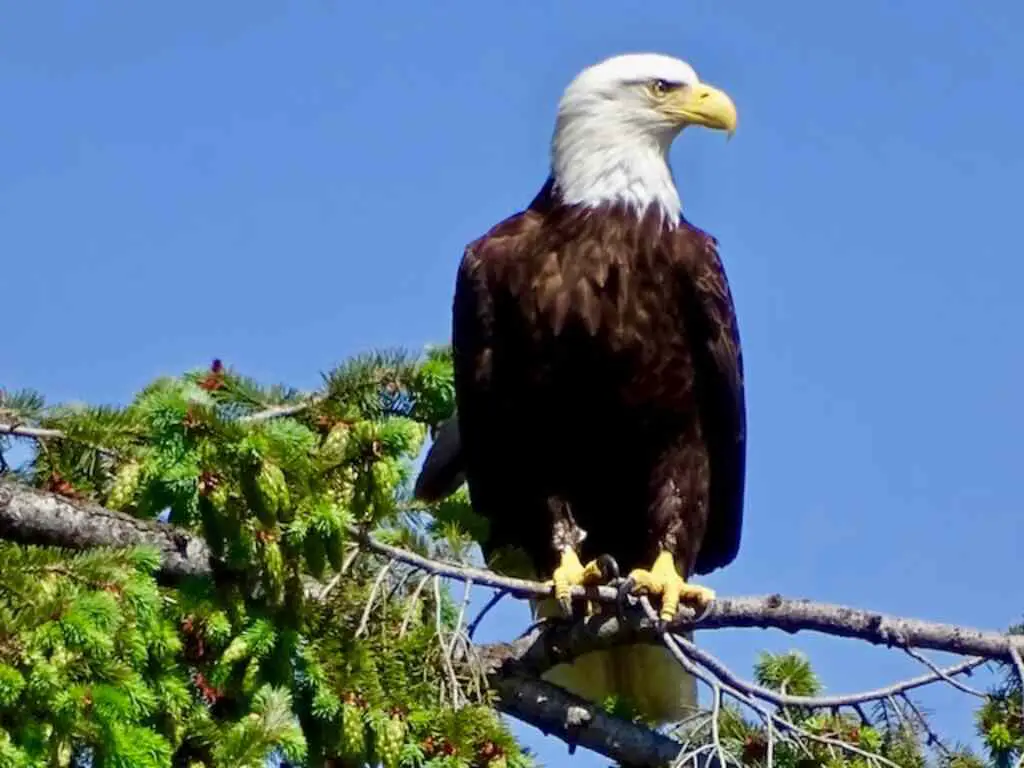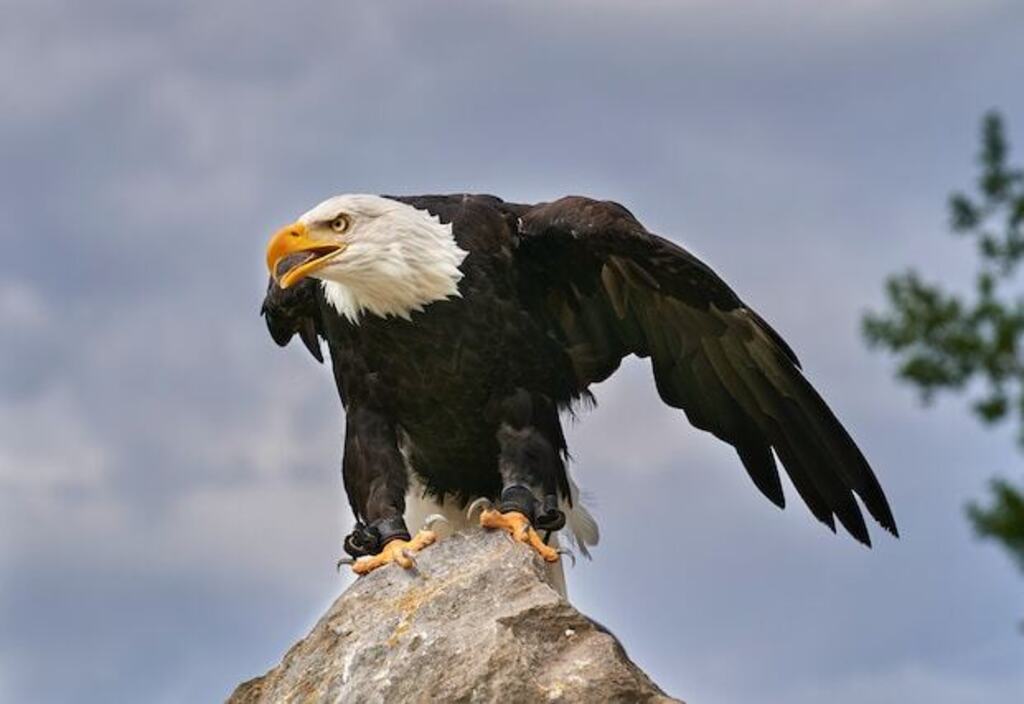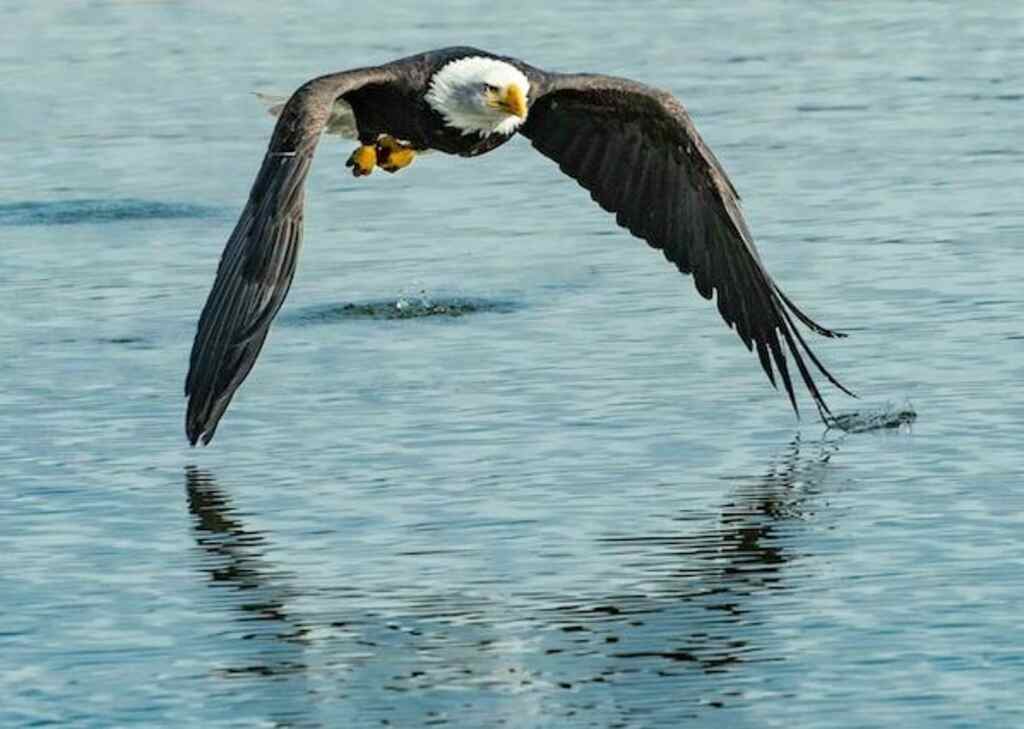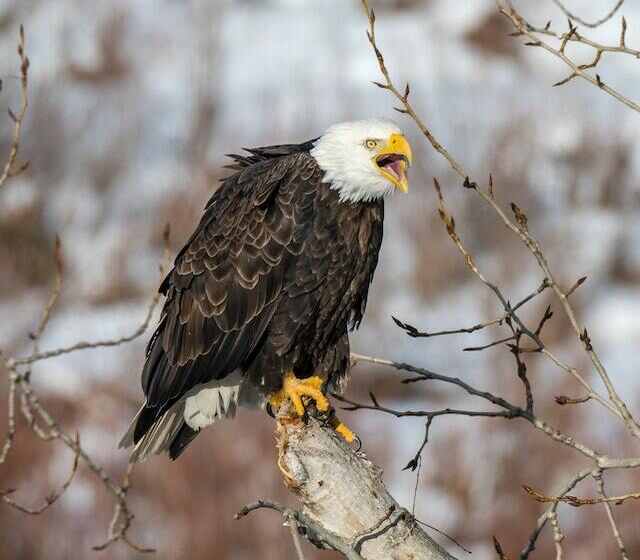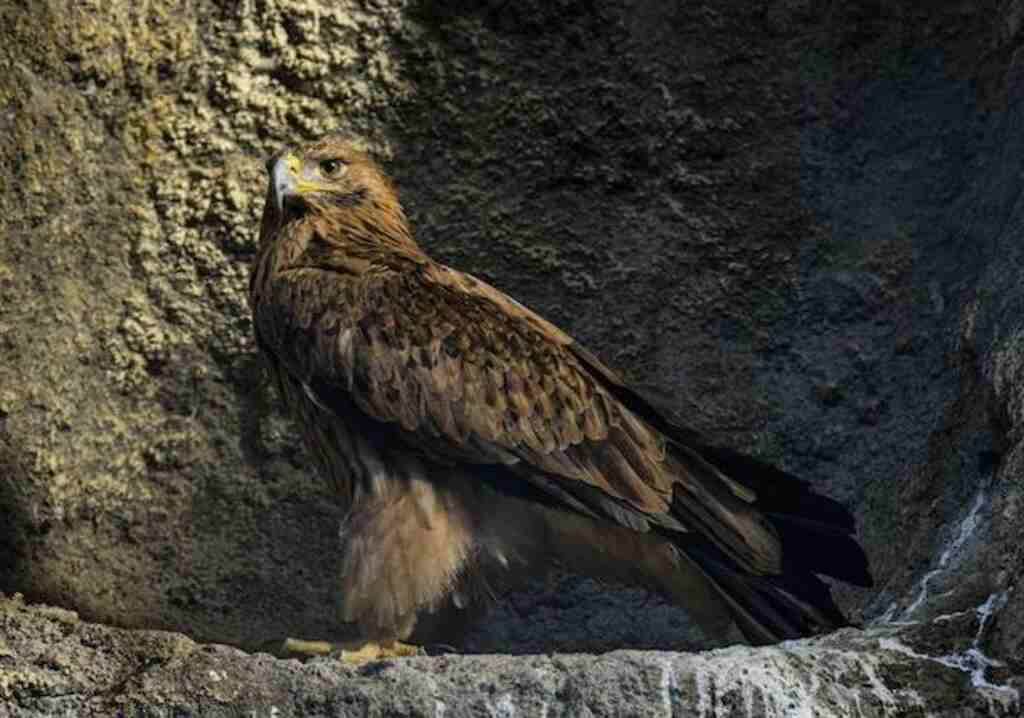Do Eagles Eat Frogs? It’s a question that might make you wonder if these regal birds indulge in some slimy amphibian delicacies. The short answer is yes, but there’s more to it than meets the eye.
Join us on a whimsical journey as we explore the surprising dining habits of eagles, uncover fascinating frog-eagle encounters, and unravel the secrets of nature’s menu.
Get ready for a captivating adventure into the world of our feathery friends!
Table of Contents
- 1 Key Takeaways
- 2 Eagle Diet: An Overview of their Feeding Habits
- 3 Hunting Techniques: How Eagles Capture Prey
- 4 Do Eagles Eat Frogs
- 5 Adaptations for Frog Consumption
- 6 Importance of Frogs in an Eagle’s Diet
- 7 Eagle Vision and Hunting Strategies
- 8 Other Prey: What Eagles Eat Besides Frogs
- 9 The Role of Frogs in Ecosystems
- 10 Conservation Concerns for Frog Populations
- 11 Interesting Facts About Eagles and Frogs
- 12 Frequently Asked Questions
- 13 Conclusion
- 14 Author
Key Takeaways
- Eagles have a diverse diet and include frogs as part of their prey.
- Frogs play a crucial role in the dietary ecosystem of eagles, and their decline can impact eagle populations.
- Eagles help control prey populations and maintain ecosystem balance by consuming frogs.
- Conservation of eagles and frogs is important for environmental health and stability.
Eagle Diet: An Overview of their Feeding Habits
Eagles, as apex predators, have a diverse diet that includes a wide range of prey items such as fish, small mammals, reptiles, and birds.
However, the consumption of frogs by eagles is not as common as other prey items. The availability of frogs in an eagle’s habitat plays a significant role in their diet composition.
Eagle populations tend to thrive in areas abundant with prey, and their diet reflects the local ecosystem dynamics.
Frog populations, on the other hand, are influenced by various factors such as climate, habitat availability, and predation pressure.
Therefore, the consumption of frogs by eagles can vary depending on the specific eagle population and the availability of frogs in their habitat.
Understanding the dynamics between eagle and frog populations provides valuable insights into the overall ecosystem health.
Transitioning to the subsequent section about hunting techniques, eagles employ various strategies to capture their prey.
Hunting Techniques: How Eagles Capture Prey
In the pursuit of their sustenance, raptors employ an array of strategies to ensnare their prey, leaving one awestruck by their cunning and precision.
Eagles, known for their remarkable hunting abilities, utilize various techniques to capture their prey.
They rely on their exceptional eyesight to spot potential prey from great distances, and once a target is identified, they descend swiftly from the sky with astonishing speed.
Eagles typically employ two main hunting strategies: aerial hunting and perch hunting.
While aerial hunting involves soaring through the air and snatching prey with their sharp talons, perch hunting involves patiently waiting on a high vantage point and then swooping down to seize the unsuspecting prey.
These hunting techniques showcase the agility and adaptability of eagles in their quest for sustenance.
Transitioning into the subsequent section about ‘adaptations for frog consumption,’ eagles have also developed specialized mechanisms to consume frogs efficiently.
Do Eagles Eat Frogs
Yes, eagles do eat frogs. Although fish make up a major part of the diet for many eagle species, these birds are opportunistic feeders and will consume frogs when the chance arises. For instance, Bald Eagles have been seen eating reptiles such as frogs, and Golden Eagles have a varied diet that includes small mammals, birds, and reptiles, including frogs.
Adaptations for Frog Consumption
One fascinating statistic reveals the efficiency of frogs as a food source for raptors. Frogs have developed various adaptations that enable them to be consumed by eagles. These adaptations include:
- Poisonous skin secretions: Some frog species produce toxic substances on their skin as a defense mechanism. This makes them unpalatable to many predators, but not to eagles, which have developed a high tolerance for these toxins.
- Camouflage: Many frog species have evolved to blend in with their surroundings, making it difficult for predators like eagles to spot them. This allows them to avoid being detected and increases their chances of survival.
- Aquatic lifestyle: Frogs spend a significant amount of time in water, which provides them with a safe haven from predators. This makes them a readily available food source for eagles that are skilled at catching prey in aquatic environments.
These feeding adaptations highlight the importance of frogs in an eagle’s diet, which will be explored in the subsequent section.
Importance of Frogs in an Eagle’s Diet
Frogs play a crucial role in the dietary ecosystem of raptors due to their unique adaptations and prevalence in aquatic environments.
As key members of the food chain, frogs serve as a valuable food source for many bird species, including eagles.
Eagles, being opportunistic hunters, rely on frogs for their nutritional needs. The decline in frog populations can have a significant impact on the eagle population.
With the reduction in their main food source, eagles may struggle to find adequate sustenance, leading to a decline in their numbers.
As such, the importance of frogs in an eagle’s diet cannot be overstated. Understanding the significance of frogs in the food chain is essential in comprehending the potential consequences of their decline.
Transitioning to the subsequent section about eagle vision and hunting strategies, it becomes evident how these adaptations allow eagles to efficiently capture their prey.
Eagle Vision and Hunting Strategies
With their exceptional eyesight and strategic hunting techniques, eagles are able to efficiently locate and capture their prey. Eagle vision plays a crucial role in their hunting success.
Their eyes are specially adapted to spot movement from great distances, allowing them to identify potential prey.
Eagles have a high density of photoreceptor cells in their retina, which enhances their visual acuity and enables them to see fine details.
Additionally, their eyes have a large fovea, a specialized area that provides sharp central vision, allowing them to focus on small objects such as frogs.
Once a frog is spotted, eagles employ various hunting strategies, such as aerial attacks or perching near water bodies to ambush their prey.
These techniques, combined with their exceptional vision, make them formidable hunters.
Transitioning into the subsequent section about ‘other prey: what eagles eat besides frogs’, eagles’ hunting abilities extend beyond just frogs.
Other Prey: What Eagles Eat Besides Frogs
Eagles have a diverse diet that includes a range of prey species beyond frogs. They occupy the top of the food chain in their ecosystems and are skilled hunters, capable of capturing a variety of prey. Some of the other prey that eagles consume in addition to frogs include:
- Small mammals: Eagles are known to hunt and feed on small mammals such as rodents, rabbits, and even small deer. These prey provide a substantial source of nutrition for the eagles.
- Fish: Eagles are adept at catching fish from bodies of water. They have sharp talons and keen eyesight that enable them to spot and capture fish swimming near the surface.
- Birds: Eagles are opportunistic hunters and will not hesitate to target other bird species. They can capture birds in mid-air or while they are perched on trees.
Eagles play a significant role in maintaining the balance of ecosystems by controlling populations of their prey species. Transitioning to the subsequent section about the role of frogs in ecosystems, it is important to understand the interdependencies between different species within these environments.
The Role of Frogs in Ecosystems
Frogs play a crucial role in ecosystems, and their decline can have significant ecological consequences.
As important predators of insects, frogs help control insect populations, ultimately influencing the balance of ecosystems.
They also serve as prey for a variety of predators, including eagles. While eagles are not solely dependent on frogs as a food source, their predation on frogs does impact the frog population.
The decline in frog populations can disrupt the delicate balance within ecosystems, leading to cascading effects on other species and ecological processes.
Understanding the ecological impact of frog predation by eagles is essential for comprehending the intricate connections within ecosystems.
Consequently, conservation concerns for frog populations arise, as preserving their populations is crucial for the overall health and stability of ecosystems.
Conservation Concerns for Frog Populations
Conservation concerns for frog populations have become increasingly prominent due to their decline, as studies indicate that the overall global frog population has decreased by approximately 30% in the past decade.
This decline has raised alarm bells among scientists and conservationists, who are actively working towards implementing effective conservation efforts to protect these vulnerable amphibians.
To shed light on the gravity of the situation, here are three important facts about the population decline of frogs:
- Habitat loss: Destruction of natural habitats, such as wetlands and forests, has significantly impacted frog populations, as they heavily rely on these ecosystems for breeding and survival.
- Pollution and climate change: Increasing pollution levels and the effects of climate change, such as rising temperatures and changing rainfall patterns, pose additional threats to frog populations, disrupting their reproductive cycles and overall health.
- Disease outbreaks: The emergence of deadly diseases, such as chytridiomycosis, has had devastating effects on frog populations worldwide, causing mass mortality.
Understanding these conservation concerns is crucial for developing effective strategies to mitigate the decline in frog populations.
Transitioning into the subsequent section about interesting facts about eagles and frogs, it is important to note the intricate ecological relationship between these two species.
Interesting Facts About Eagles and Frogs
Conservation concerns for frog populations have highlighted the need to better understand the intricate web of interactions between frogs and other species in their ecosystems. One such interaction that has drawn attention is the relationship between eagles and frogs.
Eagles, being apex predators, have been observed to prey on frogs as part of their diet. This interaction is not only fascinating, but also plays a crucial role in maintaining the balance within the ecosystem.
Frogs serve as a food source for eagles, helping to regulate their population and prevent overpopulation of certain frog species.
In return, eagles aid in controlling frog populations by consuming individuals that may be diseased or weak, thus preventing the spread of pathogens.
This symbiotic relationship between eagles and frogs showcases the intricate web of interactions within ecosystems, highlighting the importance of conserving both species for the overall health and stability of the environment.
Frequently Asked Questions
How do eagles hunt frogs?
Eagles utilize various hunting techniques to capture frogs. They rely on their exceptional eyesight and sharp talons to swoop down and snatch frogs from the water or ground. This behavior showcases the impressive hunting prowess of eagles.
What are some adaptations that eagles have for consuming frogs?
Eagles have adaptations in their digestive system and talons that enable them to consume frogs. Their digestive system is designed to break down the tough skin and bones, while their talons provide a strong grip to catch and hold onto slippery prey.
Why are frogs important in an eagle’s diet?
Frogs are important in an eagle’s diet due to their role in maintaining ecosystem balance. However, the decline in frog populations can impact eagle behavior, leading to changes in foraging patterns and potentially affecting the overall health of eagle populations.
What other prey do eagles eat besides frogs?
The eagle diet consists of various prey besides frogs. They consume a wide range of animals including fish, small mammals, birds, reptiles, and invertebrates. This diversity ensures a balanced diet and supports the conservation of frog populations.
What are some conservation concerns for frog populations?
Conservation efforts for frog populations are crucial due to habitat loss. This loss is caused by factors such as deforestation, pollution, and climate change. Urgent action is needed to protect their habitats and ensure their survival.
Conclusion
In conclusion, eagles have a diverse diet that includes frogs as an important component. Their hunting techniques and adaptations allow them to effectively capture and consume frogs, highlighting the significance of these amphibians in their diet.
Despite their ability to consume other prey, frogs play a crucial role in maintaining balanced ecosystems.
However, conservation concerns surrounding frog populations pose a potential threat to eagle food sources.
Therefore, understanding and addressing these concerns is vital for the long-term survival of both eagles and frogs alike.

